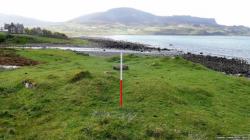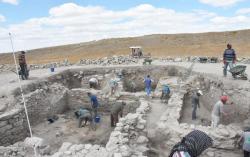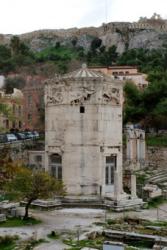INSTITUT SUPERIEUR D'ANTHROPOLOGIE
INSTITUTE OF ANTHROPOLOGY
ONLINE COURSES / COURS A DISTANCE
FALL TERM : OCTOBER 2015
REGISTER NOW
CHYPRE –  Akrotiri - Archaeologists from the University of Leicester are in a race against time to uncover the heritage of a threatened 1,500-year-old site on a Cyprus shoreline, they said on Wednesday. Between September 9 and 23 an expert team, from the University’s School of Archaeology and Ancient History, will conduct a small-scale archaeological excavation at Dreamer’s Bay, inside the UK’s Cyprus airbase, RAF Akrotiri. “This site, a late Roman/early Byzantine harbour complex, is a significant part of the heritage of the Akrotiri Peninsula, and has been known about for some decades but not adequately explored and documented,” an announcement from the University said. Simon James, Professor of Archaeology at Leicester, said: “We aim to conduct a rescue excavation on wave-threatened heritage remains along the shoreline, in the form of a series of simple masonry buildings, probably warehouses, which appear to belong to the port which existed here in late Roman/early Byzantine times, probably between AD 300 and 600. “These structures are being rapidly eroded by the sea during winter storms,” he added.
Akrotiri - Archaeologists from the University of Leicester are in a race against time to uncover the heritage of a threatened 1,500-year-old site on a Cyprus shoreline, they said on Wednesday. Between September 9 and 23 an expert team, from the University’s School of Archaeology and Ancient History, will conduct a small-scale archaeological excavation at Dreamer’s Bay, inside the UK’s Cyprus airbase, RAF Akrotiri. “This site, a late Roman/early Byzantine harbour complex, is a significant part of the heritage of the Akrotiri Peninsula, and has been known about for some decades but not adequately explored and documented,” an announcement from the University said. Simon James, Professor of Archaeology at Leicester, said: “We aim to conduct a rescue excavation on wave-threatened heritage remains along the shoreline, in the form of a series of simple masonry buildings, probably warehouses, which appear to belong to the port which existed here in late Roman/early Byzantine times, probably between AD 300 and 600. “These structures are being rapidly eroded by the sea during winter storms,” he added.
http://cyprus-mail.com/2015/09/02/rescue-excavation-at-threatened-cypriot-archaeological-site/
ROYAUME UNI –  Staffin - Archaeologists have teamed up with a north Skye community organisation to investigate a coastal site which could illustrate what life was like in the area thousands of years ago. The trust has identified a site just above the shore in Staffin Bay, which it is keen to investigate in order to enhance the Staffin Ecomusem project. Mesolithic flints have been eroding from the edge of the Garafad Common Grazing for several years. A sub-circular structure, which could be a house, also sits on top of the site, adding to the collection of prehistoric sites in the area. The work will start next Wednesday (9th September) and continue until Monday 14th. Geophysical survey and a small excavation will be used to characterise and date the site, helping to discover what life was like in Staffin during the Mesolithic period, some 8,000 years ago. During the Mesolithic, Scotland was inhabited by hunter-gatherers who lived off the wild resources of the land and sea.
Staffin - Archaeologists have teamed up with a north Skye community organisation to investigate a coastal site which could illustrate what life was like in the area thousands of years ago. The trust has identified a site just above the shore in Staffin Bay, which it is keen to investigate in order to enhance the Staffin Ecomusem project. Mesolithic flints have been eroding from the edge of the Garafad Common Grazing for several years. A sub-circular structure, which could be a house, also sits on top of the site, adding to the collection of prehistoric sites in the area. The work will start next Wednesday (9th September) and continue until Monday 14th. Geophysical survey and a small excavation will be used to characterise and date the site, helping to discover what life was like in Staffin during the Mesolithic period, some 8,000 years ago. During the Mesolithic, Scotland was inhabited by hunter-gatherers who lived off the wild resources of the land and sea.
http://www.whfp.com/2015/09/02/archaeologists-to-explore-staffins-mesolithic-past/
USA – Cowpens - After two weeks and 40 acres, a new archaeological search at Cowpens National Battlefield has produced artifacts believed to be from the Battle of Cowpens during the Revolutionary War. Archaeologists from the National Park Service’s Southeast Archaeological Center in Tallahassee, Fla., started the dig last month to recover any artifacts that could have been left from the battle. During the two-week dig, archaeologists and volunteers found a number of musket balls and rifle balls around the battlefield. All of the artifacts will be taken to the archaeological center and analyzed to determine whether they are American or British, said Cowpens National Battlefield Park Ranger Virginia Fowler.
http://www.thestate.com/news/local/article33401403.html
TURQUIE –  Yassıhöyük - Excavation work at Ovaören village in Central Anatolian Nevşehir province has brought to light a settlement in ancient Yassıhöyük dating back to 1,700 B.C. The ancient site could, however, even date back to 6,000 B.C., said the head of the excavation team and the director of the Gazi University Archaeology Department, Yücel Şenyurt. A team of 23 archaeologists along with 26 people from Ovaören have been carrying out the excavation works, which were launched in 2007 by a decision of the Council of Ministers. Yassıhöyük along with Topakhöyük and its booms constitute the largest excavation fields in Turkey at some 350,000 square meters. The works revealed the oldest settlement, formed in Topakhöyük around 2,500 B.C., has been a rich settlement regarding the archaeological findings, build-up plan and tombs. “The printing of the seals [found during the excavation] shows that a trade colony had lived in the area. In Yassıhöyük, we have been trying to document the settlement of Hittites lying under these architectural layers dating back to the Iron Age. We have also revealed that this urban-looking settlement of Yassıhöyük was surrounded by defense systems in the Middle Iron Age, as in the Hittite Age. The ruins of seven-meter-long walls and the portals of the town in Ovaören-Yassıhöyük will become important tourism destinations in the near future, I believe,” said Şenyurt.
Yassıhöyük - Excavation work at Ovaören village in Central Anatolian Nevşehir province has brought to light a settlement in ancient Yassıhöyük dating back to 1,700 B.C. The ancient site could, however, even date back to 6,000 B.C., said the head of the excavation team and the director of the Gazi University Archaeology Department, Yücel Şenyurt. A team of 23 archaeologists along with 26 people from Ovaören have been carrying out the excavation works, which were launched in 2007 by a decision of the Council of Ministers. Yassıhöyük along with Topakhöyük and its booms constitute the largest excavation fields in Turkey at some 350,000 square meters. The works revealed the oldest settlement, formed in Topakhöyük around 2,500 B.C., has been a rich settlement regarding the archaeological findings, build-up plan and tombs. “The printing of the seals [found during the excavation] shows that a trade colony had lived in the area. In Yassıhöyük, we have been trying to document the settlement of Hittites lying under these architectural layers dating back to the Iron Age. We have also revealed that this urban-looking settlement of Yassıhöyük was surrounded by defense systems in the Middle Iron Age, as in the Hittite Age. The ruins of seven-meter-long walls and the portals of the town in Ovaören-Yassıhöyük will become important tourism destinations in the near future, I believe,” said Şenyurt.
http://www.hurriyetdailynews.com/settlement-in-yassihoyuk-could-date-back-to-6000-bc-say-archaeologists.aspx?pageID=238&nid=87834
GRECE –  Athenes - The Greek Culture Ministry announced two significant finds on Friday at the archaeological sites of Kerameikos Cemetery and Roman Agora, at the centre of Athens. At the archaeological site of Kerameikos archaeologists from the German Archaeological Institute brought to light a well probably used for hydromancy rituals. The well was revealed when archaeologists overturned a marble stone and it bore an inscription on the walls addressed to Apollo, the ancient Greek god of phrophecy and was probably used for divination in early Roman times, as the lettering suggests. The finding is exceptionally significant as it identifies the spot as the first and unique Apollo divination site in Athens, confirming the worshipping of the ancient god along with his sister Artemis and restoring the accurate interpretation of the site as a shrine rendered by K. Mylonas in the late 19th century to a third goddess, Hecate. The invocation phrase on the walls of the well is: “ΕΛΘΕ ΜΟΙ Ω ΠΑΙΑΝ ΦΕΡΩΝ ΤΟ ΜΑΝΤΕΙΟΝ ΑΛΗΘΕC” . According to a Greek Culture Ministry announcement, the identification of more than 20 inscriptions with relevant content highlights the well’s connection with the sanctuary of Apollo in Athens. The excavation was carried out under the direction of Dr Jutta Stroszeck from the German Archaeological Institute and the supervision of the Ephorate of Antiquities of Athens. Another significant finding was made at the Roman Agora, in the Horologion of Andronikos Kyrrhestes or Tower of the Winds in particular. In the 2nd century BC monument, during maintenance works, fragments of murals with Christian content have been revealed for the first time. More accurate dating of the findings will be published by the Ephorate of Antiquities of Athens after they are fully revealed. However, the repeated use of the monument throughout Byzantine times is confirmed, something that has probably contributed to the preservation of the Tower.
Athenes - The Greek Culture Ministry announced two significant finds on Friday at the archaeological sites of Kerameikos Cemetery and Roman Agora, at the centre of Athens. At the archaeological site of Kerameikos archaeologists from the German Archaeological Institute brought to light a well probably used for hydromancy rituals. The well was revealed when archaeologists overturned a marble stone and it bore an inscription on the walls addressed to Apollo, the ancient Greek god of phrophecy and was probably used for divination in early Roman times, as the lettering suggests. The finding is exceptionally significant as it identifies the spot as the first and unique Apollo divination site in Athens, confirming the worshipping of the ancient god along with his sister Artemis and restoring the accurate interpretation of the site as a shrine rendered by K. Mylonas in the late 19th century to a third goddess, Hecate. The invocation phrase on the walls of the well is: “ΕΛΘΕ ΜΟΙ Ω ΠΑΙΑΝ ΦΕΡΩΝ ΤΟ ΜΑΝΤΕΙΟΝ ΑΛΗΘΕC” . According to a Greek Culture Ministry announcement, the identification of more than 20 inscriptions with relevant content highlights the well’s connection with the sanctuary of Apollo in Athens. The excavation was carried out under the direction of Dr Jutta Stroszeck from the German Archaeological Institute and the supervision of the Ephorate of Antiquities of Athens. Another significant finding was made at the Roman Agora, in the Horologion of Andronikos Kyrrhestes or Tower of the Winds in particular. In the 2nd century BC monument, during maintenance works, fragments of murals with Christian content have been revealed for the first time. More accurate dating of the findings will be published by the Ephorate of Antiquities of Athens after they are fully revealed. However, the repeated use of the monument throughout Byzantine times is confirmed, something that has probably contributed to the preservation of the Tower.
http://www.archaeology.wiki/blog/2015/08/31/new-significant-finds-centre-athens-archaeological-sites/